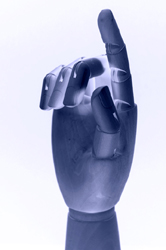From perception to action
Strong motivation for the development of this innovative prosthetic hand device was provided by the task-oriented interest of the user community. Patients frequently express the need to replace their missing limb with a functional hand replacement that will enable them to perform the activities of daily living autonomously. The cybernetic hand is by definition connected by neural interfaces to a human and thus makes it possible to exploit sensory - motor coordination mechanisms for controlling grasping forces. Because it does not just mimic the human musculoskeletal structure, neural signals that used to arrive at the original hand's muscles are interpreted to correlate with the joint movements. While the ultimate aim was to connect the CyberHand through neural interfaces implanted in peripheral nerves, its modular design allows the exploitation and importantly, the validation of different neural interfaces. Research at the Fraunhofer - Institut für Biomedizinische Technik moved towards the development of implantable telemetry systems for the recording of electroneurographic signals and stimulation of peripheral nerves. The CyberHand's sensory system included sensors, intended to functionally emulate touch sensors in the human skin and produce information about the interaction between the hand and the object reached. Biological touch sensors represent physical properties of the environment in contact with the skin and are found in several distinct structures within the human skin. Responses of sensory neurons to mechanical stimulation, such as touching and tissue compression, were investigated with a pneumatic stimulator. The ultrasonic sensor incorporated in the stimulation tip provided the essential contact information. The modular design of the CyberHand makes it comparatively easy to exploit its advanced technologies and test scientific hypotheses for the functional role of biological sensors during manipulation tasks. Undoubtedly, implementations of arrays of flexible sensors, assembled as an external 'skin' can be expected in the future with mechanical properties similar to those of natural skin.







